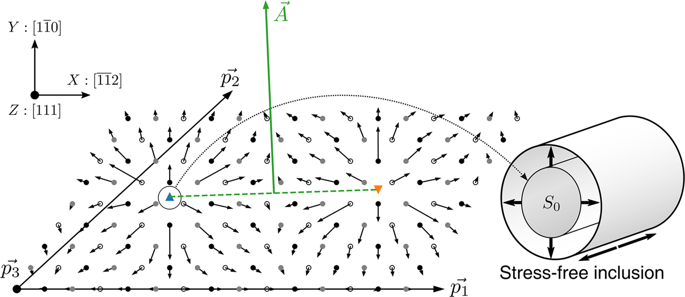npj Computational Materials ( IF 9.7 ) Pub Date : 2019-11-14 , DOI: 10.1038/s41524-019-0247-3 Antoine Kraych , Emmanuel Clouet , Lucile Dezerald , Lisa Ventelon , François Willaime , David Rodney

|
A hallmark of low-temperature plasticity in body-centered cubic (BCC) metals is its departure from Schmid’s law. One aspect is that non-glide stresses, which do not produce any driving force on the dislocations, may affect the yield stress. We show here that this effect is due to a variation of the relaxation volume of the \(1/2\langle 111\rangle\) screw dislocations during glide. We predict quantitatively non-glide effects by modeling the dislocation core as an Eshelby inclusion, which couples elastically to the applied stress. This model explains the physical origin of the generalized yield criterion classically used to include non-Schmid effects in constitutive models of BCC plasticity. We use first-principles calculations to properly account for dislocation cores and use tungsten as a reference BCC metal. However, the methodology developed here applies to other BCC metals, other energy models and other solids showing non-glide effects.
中文翻译:

BCC金属中的非滑移效应和位错核心场
体心立方(BCC)金属的低温可塑性的一个标志是它偏离了施密德定律。一方面是,对位错不产生任何驱动力的非滑移应力可能会影响屈服应力。我们在这里显示此效果是由于\(1/2 \ langle 111 \ rangle \)的弛豫体积的变化滑行时螺丝脱位。我们通过将位错核心建模为Eshelby夹杂物来定量地预测非滑移效应,该夹杂物弹性地耦合到施加的应力。该模型解释了通常用于将非施密特效应包括在BCC可塑性本构模型中的广义屈服准则的物理起源。我们使用第一性原理计算来适当地计算位错核心,并使用钨作为BCC基准金属。但是,此处开发的方法适用于其他BCC金属,其他能量模型和其他显示非滑移效应的固体。



























 京公网安备 11010802027423号
京公网安备 11010802027423号